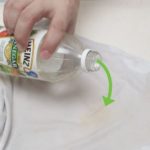Using Vinegar
Vinegar is an effective agent for removing pesticide residues from fruits and vegetables. Some recommend mixing a solution of 4 parts water to 1 part vinegar for about 20 minutes, but pure vinegar can also be used for a more thorough removal of pesticides.
Vinegar is also capable of eliminating various bacteria that may be present on produce. However, for thin-skinned fruits such as berries, soaking them in vinegar may affect their outer appearance.
Soaking Produce in Lemon-Infused Water
Potatoes and peppers are particularly susceptible to pesticides, so it is advisable to peel potatoes and then soak them in clean water with a small amount of lemon juice. Lemon juice is effective due to its acidic nature. A moderate soak of 10 minutes in lemon-infused water should suffice.
Rice Water

Rice water is excellent for neutralizing pesticides in fruits and vegetables. Soak your produce in rice water for 5 to 10 minutes to help counteract the toxins from pesticides that may remain on the surface.
Saltwater Soak
Research indicates that soaking fruits and vegetables in a 10% saltwater solution for 20 minutes will eliminate most traces of the four most common types of pesticides.
Cleaning Produce with a Baking Soda and Water Solution

Another effective method is to use 28 grams of baking soda with nearly 3 liters of water. Soak your produce for 12 to 15 minutes in this solution, and then rinse it thoroughly with clean water.
While these methods are helpful for removing pesticides from the surface of fruits and vegetables, it is important to note that some pesticides penetrate deep into the cells of the leaves and are challenging to eliminate. Even with heat treatment, such as boiling or cooking, stimulant residues may remain. Therefore, the best approach is to choose pesticide-free produce from the very beginning of your shopping journey.
Identifying Pesticide-Free Produce
According to TS. Vu Thanh Hai, Head of the Department of Vegetables and Fruits at the Vietnam Academy of Agricultural Sciences, it is challenging to identify pesticide-free produce based on sensory evaluation alone. The most accurate method is to use a kit test, which involves extracting the juice from the produce and adding testing chemicals. If there is a change in color, it indicates the presence of pesticide residues.
Contrary to popular belief, shiny, vibrant vegetables are not necessarily an indication of excessive stimulant use. In some cases, organic farming methods and proper nutrient management can produce equally attractive and healthy-looking vegetables without relying on inorganic fertilizers and pesticides.
An unusual odor in your produce may indicate an abnormality, but it does not necessarily mean pesticide contamination. If the farmer does not follow the proper waiting period after applying fertilizers or stimulants, any chemical smell will likely dissipate within a day or two.
Vu Thanh Hai recommends purchasing from reputable suppliers who can guarantee the source and safety of their produce. When buying from local markets, it is challenging to determine the presence of pesticides without a kit test.
Additionally, it is best to avoid off-season produce, as they tend to require more pesticides and growth stimulants due to unfavorable natural conditions. During the off-season, plants struggle to grow, and pest and disease pressures are higher, leading to increased reliance on chemical interventions.
According to Nguoiduatin



































